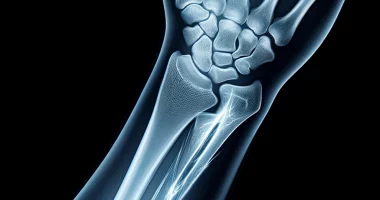Familial adenomatous polyposis
Definition
Familial adenomatous polyposis is a rare inherited disorder in which multiple adenomatous polyps develop in the large intestine. It is manifested by pain, frequent stools, blood in the feces, anemia, pale skin, and increased fatigue. There is a high probability of malignization. In addition to neoplasia of the large intestine, bone and soft tissue neoplasms may be detected in familial polyposis of the colon. Complaints, physical examination data, irrigoscopy, sigmoidoscopy, and colonoscopy with biopsy are used when diagnosing the disease. Treatment – colectomy with the formation of ileoproctoanastomosis or ileostomy.
General information
Familial colonic polyposis is a genetically determined pathology characterized by multiple polyps in the large intestine. The number of polyps can range from a hundred to a thousand or more. In the absence of treatment, obligatory malignization is noted. Familial polyposis affects one out of 6-12 thousand inhabitants of the Earth. There are several subtypes of the disease. All of them, regardless of the clinical manifestations and the type of adenomatous polyps, end with the formation of adenocarcinoma.
The first signs of familial polyposis of the colon usually occur in adolescence, and malignization is observed after 30-40 years of age. There may be an aggressive course with the appearance of the first symptoms in preschool age and malignization before 30 years of age, as well as a sterile course with the formation of the clinical picture after 40 years of age and malignization after 50. Treatment is provided by specialists in oncology, gastroenterology, and abdominal surgery.
Causes and pathologic anatomy
The disease is autosomal dominant and is caused by a mutation in the ARS gene located in the long arm of chromosome 5. Both men and women are affected. It is accompanied by forming many polyps of the same or different structures. Large and small polyps with a broad base, short or long legs, and villous or lobular surfaces can be detected. With the predominance of large polyps, there is a higher probability of malignancy.
Specialists distinguish different groups of familial polyposis of the colon, taking into account the presence or absence of extraintestinal manifestations of the disease. The most common variant is the Gardner syndrome, in which polyposis of the large intestine is combined with soft tissue neoplasms, osteomas, and osteofibromas. In most cases, extraintestinal neoplasia is benign. The prevalence of combined forms of familial polyposis colorectal polyposis is still in question. Presumably, isolated intestinal lesions are observed in 25% of cases, in combination with extraintestinal tumors – in 75% of cases. Bone neoplasia is considered the most common extraintestinal manifestation, occurring in 80% of patients with combined forms of the disease. Cysts are diagnosed in 35%, and desmoid tumors – in 18% of patients.
Symptoms
In most cases, the first symptoms of familial polyposis occur at the age of 15-19 years. In the aggressive course, the disease manifests at 5-6 years and in the weakened (attenuated) form – at over 40 years. Patients complain of abdominal pain and increased frequency of stools up to 5-6 times a day. Pain syndrome in familial polyposis of the colon is characterized by a great variety; pain may occur predominantly in the upper or lower abdomen, be aching, twisting, sharp, etc. Gastric discomfort is possible, which is why specialists sometimes emphasize the examination of the upper GI tract. In the fecal masses, impurities of blood and mucus are detected. Profuse bleeding rarely develops.
A few years after the manifestation of familial polyposis of the colon, the number of polyps increases, and they become larger. The presence of numerous tumors causes disorders of absorption and secretory processes. Traumatization of more numerous and larger polyps becomes the cause of increasing blood loss. As a rule, this stage of familial polyposis of the colon falls on the period of increasing the load on the patient’s body: young men go into the army, girls get pregnant, and give birth to children, which further aggravates the above violations. There is weakness and increased fatigue. Anemia develops.
Subsequently, familial colonic polyposis is relatively stable. Deterioration of the patient’s condition may be due to a further increase in the number of polyps or the occurrence of extraintestinal neoplasia. With the malignization of polyps, symptoms of oncological disease occur. The condition of patients with familial polyposis of the colon is destabilized, and there is a worsening of anemia, weight loss, hyperthermia, and marked pallor of the skin. Patients complain of intense pain. When the tumor decays, profuse bleeding may be observed. When the lumen of the intestine is narrowed, symptoms of intestinal obstruction occur.
Diagnosis of familial polyposis of the colon
Due to the weakness of the clinical symptoms of this disease in adolescence and young adulthood, timely diagnosis is of particular importance, followed by regular observation and decision-making on the conduct of a particular surgical intervention before the onset of malignization of polyps. When collecting anamnesis, attention is paid to characteristic symptoms (frequent stools, anemia, blood and mucus in feces), family history (presence of relatives with familial polyposis of the colon), and extraintestinal manifestations of the disease.
In some cases, polyps can be detected already at the stage of rectal examination. Sigmoidoscopy is performed to assess the lower intestine and to determine the severity of familial polyposis of the colon. Then, a colonoscopy is performed. In the process of endoscopic examination, attention is paid to larger cherry or bright red nodes with loose or lobular surfaces (villous polyps) since such tumors are characterized by an increased likelihood of malignization.
In addition to endoscopy, patients with familial colonic polyposis undergo irrigoscopy, which is of particular diagnostic value in the presence of circular neoplasia that prevents the advancement of the endoscope. Patients are referred for gastroduodenoscopy because familial colonic polyposis is often accompanied by gastritis or gastric polyposis. External examination is performed to detect extraintestinal manifestations of the disease. Radiography and CT are carried out for bone neoplasia patients, and soft tissue – MRI of the affected area is performed.
Treatment and prognosis
The only treatment for this disease is surgical intervention. Since familial polyposis is an obligate precancer, surgery is aimed at complete removal of the polyp-affected parts of the large intestine. The most reliable way to prevent colorectal cancer in these conditions is the complete removal of the large intestine and the formation of a permanent ileostomy until signs of malignization appear. This approach, for obvious reasons, usually does not suit young active patients with familial polyposis of the colon, so the question of the timing and extent of surgery remains debatable.
Polyp-free areas are preserved. Endoscopic removal of neoplasia is performed in the presence of single nodules in individual segments. Then, resection of all affected parts of the intestine (in practice, this usually means removing most of the intestine) is performed. If possible, try to preserve the sphincter of the anus. The operation of choice in familial polyposis of the colon may be colectomy with ileorectal anastomosis, subtotal resection of the colon and rectum with relegation of the colon to the area of the anal canal, etc. In case of malignization and complete intestinal involvement, colectomy combined with extirpation or peritoneal resection of the rectum and ileostomy is required.
If untreated, the prognosis in familial colonic polyposis is unfavorable. Over time, one or more polyps transform into malignant neoplasms. Before the appearance of signs of malignization sphincter- sphincter-preserving surgical intervention can be performed in 85% of cases and after symptoms of oncological disease symptoms – in 30% of cases. All patients who have undergone surgical interventions for familial polyposis of the colon should be on dispensary observation. Patients undergo endoscopic examinations regularly to detect malignant polyps in the preserved parts of the intestine in a timely manner. Assign tests to assess the state of protein and salt metabolism.
All these treatment options are available in more than 700 hospitals worldwide (https://doctor.global/results/diseases/familial-adenomatous-polyposis). For example, Proctocolectomy can be performed in following countries for an approximate price of:
Turkey$12.9 K in 25 clinics
China$22.1 K in 6 clinics
Germany$42.0 K in 43 clinics
Israel$47.4 K in 11 clinics
United States$68.3 K in 15 clinics.


